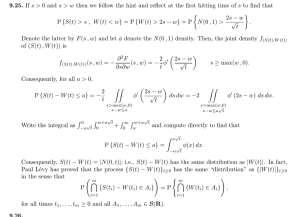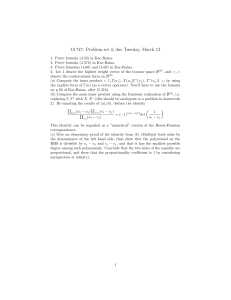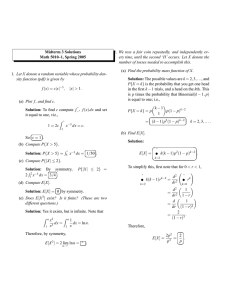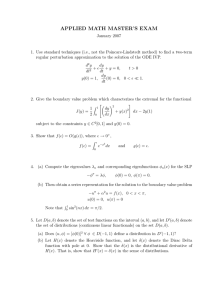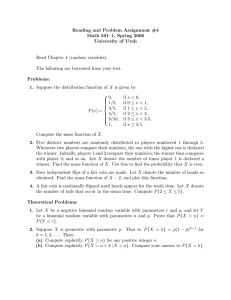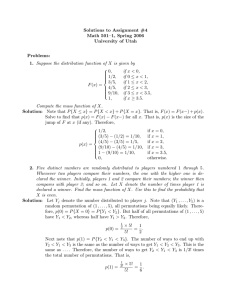Chapter 2 Problems
advertisement
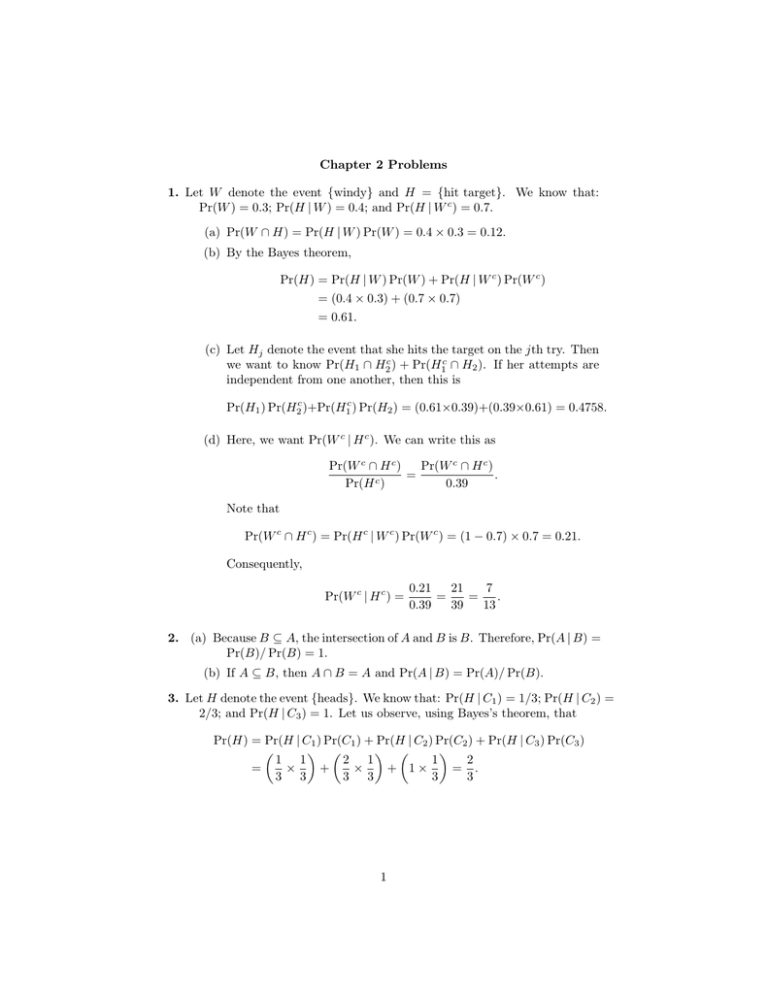
Chapter 2 Problems
1. Let W denote the event {windy} and H = {hit target}. We know that:
Pr(W ) = 0.3; Pr(H | W ) = 0.4; and Pr(H | W c ) = 0.7.
(a) Pr(W ∩ H) = Pr(H | W ) Pr(W ) = 0.4 × 0.3 = 0.12.
(b) By the Bayes theorem,
Pr(H) = Pr(H | W ) Pr(W ) + Pr(H | W c ) Pr(W c )
= (0.4 × 0.3) + (0.7 × 0.7)
= 0.61.
(c) Let Hj denote the event that she hits the target on the jth try. Then
we want to know Pr(H1 ∩ H2c ) + Pr(H1c ∩ H2 ). If her attempts are
independent from one another, then this is
Pr(H1 ) Pr(H2c )+Pr(H1c ) Pr(H2 ) = (0.61×0.39)+(0.39×0.61) = 0.4758.
(d) Here, we want Pr(W c | H c ). We can write this as
Pr(W c ∩ H c )
Pr(W c ∩ H c )
=
.
Pr(H c )
0.39
Note that
Pr(W c ∩ H c ) = Pr(H c | W c ) Pr(W c ) = (1 − 0.7) × 0.7 = 0.21.
Consequently,
Pr(W c | H c ) =
0.21
21
7
=
=
.
0.39
39
13
2. (a) Because B ⊆ A, the intersection of A and B is B. Therefore, Pr(A | B) =
Pr(B)/ Pr(B) = 1.
(b) If A ⊆ B, then A ∩ B = A and Pr(A | B) = Pr(A)/ Pr(B).
3. Let H denote the event {heads}. We know that: Pr(H | C1 ) = 1/3; Pr(H | C2 ) =
2/3; and Pr(H | C3 ) = 1. Let us observe, using Bayes’s theorem, that
Pr(H) = Pr(H | C1 ) Pr(C1 ) + Pr(H | C2 ) Pr(C2 ) + Pr(H | C3 ) Pr(C3 )
1 1
2 1
1
2
=
×
+
×
+ 1×
= .
3 3
3 3
3
3
1
• For the first portion, we are asked to compute Pr(Ck | H). But this
is Pr(H | Ck ) Pr(Ck )/ Pr(H). Therefore,
Pr(C1 | H) =
Pr(C2 | H) =
Pr(C3 | H) =
1
3
×
1
3
2
3
2
3
×
1
3
2
3
1×
2
3
1
3
=
1
,
6
=
1
,
3
=
1
.
2
• Let Hj denote the event that the jth attempt leads to heads. We are
asked to compute Pr(H2 | H1 ). We may observe that
Pr(H2 | H1 )
= Pr(H2 ∩ C1 | H1 ) + Pr(H2 ∩ C2 | H1 ) + Pr(H2 ∩ C3 | H1 ).
Now:
Pr(H2 ∩ C1 | H1 ) = Pr(H1 ∩ H2 | C1 )
2
1
1/3
3
2/3
2
2
1/3
=
3
2/3
1/3
= (1)2
=
2/3
Pr(C1 )
=
Pr(H1 )
Pr(C2 )
Pr(H1 )
Pr(C3 )
Pr(H2 ∩ C3 | H1 ) = Pr(H1 ∩ H2 | C3 )
Pr(H1 )
Pr(H2 ∩ C2 | H1 ) = Pr(H1 ∩ H2 | C2 )
=
1
;
18
=
2
;
9
1
.
2
Consequently,
Pr(H2 | H1 ) =
2 1
7
1
+ + = .
18 9 2
9
• We first note that
Pr(Ck )
Pr(H1 ∩ H2 )
Pr(Ck )
= Pr(H1 ∩ H2 | Ck )
Pr(H2 | H1 ) Pr(H1 )
Pr(Ck | H1 ∩ H2 ) = Pr(H1 ∩ H2 | Ck )
= Pr(H1 ∩ H2 | Ck )
=
1
3
7
9
×
9
Pr(H1 ∩ H2 | Ck ).
14
2
2
3
Therefore,
2
1
3
2
9 2
Pr(C2 | H1 ∩ H2 ) =
14 3
9
Pr(C3 | H1 ∩ H2 ) =
(1)2 =
14
Pr(C1 | H1 ∩ H2 ) =
9
14
=
1
;
14
=
2
;
7
9
.
14
• We proceed as before, and write
Pr(H3 | H1 ∩ H2 )
= Pr(H3 ∩ C1 | H1 ∩ H2 ) + Pr(H3 ∩ C2 | H1 ∩ H2 )
+ Pr(H3 ∩ C3 | H1 ∩ H2 ).
But
Pr(H3 ∩ Ck | H1 ∩ H2 ) = Pr(H1 ∩ H2 ∩ H3 | Ck )
1
3
3
= (Pr(H | Ck ))
Pr(H2 | H1 ) Pr(H1 )
1
3
3
= (Pr(H | Ck ))
=
Pr(Ck )
Pr(H1 ∩ H2 )
7
9
×
2
3
9
3
(Pr(H | Ck )) .
14
Therefore,
3
1
1
=
;
3
42
3
9
2
9
Pr(H3 ∩ C2 | H1 ∩ H2 ) =
×
=
;
14
3
21
9
9
Pr(H3 ∩ C3 | H1 ∩ H2 ) =
× (1)3 =
.
14
14
9
×
Pr(H3 ∩ C1 | H1 ∩ H2 ) =
14
Therefore,
Pr(H3 | H1 ∩ H2 ) =
9
9
6
1
+
+
= .
42 21 14
7
4. (a) Pr(A∩A) = Pr(A), but by independence, Pr(A∩A) = | Pr(A)|2 . Therefore, Pr(A) is a solution to x = x2 . If x 6= 0, then we can divide by
x to find that x = 1. This proves that Pr(A) is zero or one.
(b) Because they are disjoint, Pr(A ∩ B) = 0. So unless Pr(A) = 0 or
Pr(B) = 0, or both are zero, A and B cannot be independent. [“If A
happens, then we know that B does not; and vice versa.”]
3
(c) Because B = (A ∩ B) ∪ (Ac ∩ B) is a disjoint union,
Pr(Ac ∩ B) = Pr(B) − Pr(A ∩ B)
= Pr(B) − Pr(A) Pr(B)
= Pr(B) [1 − Pr(A)]
= Pr(B) Pr(Ac ).
Thus, Ac and B are independent. Similarly, Pr(Ac ∩ B c ) + Pr(Ac ∩
B) = Pr(Ac ). Solve and apply the independence of Ac and B to find
that
Pr(Ac ∩ B c ) = Pr(Ac ) − Pr(Ac ) Pr(B) = Pr(Ac ) Pr(B c ).
14. The probability in question is
n
n
n
\
Y
Y
Acj =
Pr(Acj ) =
(1 − Pr(Aj )),
Pr
j=1
where
Qn
j=1
j=1
j=1
αj denotes the product α1 × · · · × αn .
I claim that for
1 − x ≤ e−x
for all x ≥ 0.
(1)
If so, then
Pr
n
\
Acj ≤
j=1
n
Y
e− Pr(Aj ) = e−
Pn
j=1
Pr(Aj )
,
j=1
as desired. In order to prove (1) we apply Taylor’s expansion with remainder to the function f (x) = e−x , and find that
e−x = 1 − x + θ2
for some 0 ≤ θ ≤ x.
Because θ2 ≥ 0, (1) follows.
34. Let C = {cured}. Then,
Pr(C | A) =
60
3
=
200
10
and
Pr(C | B) =
170
17
=
.
1100
110
For the second part, let M = {male} and F = {female}. We want to
compute Pr(C | M ∩ A), Pr(C | M ∩ B), Pr(C | F ∩ A), and Pr(C | F ∩ B).
We can see that A is “better than” B in the sense that 3/10 = 0.3 is
greater than 17/110 = 0.154.
4
Then, we note that
50
1
= ;
100
2
60
3
Pr(C | M ∩ B) =
= ;
100
5
1
10
=
;
Pr(C | F ∩ A) =
100
10
11
110
=
.
Pr(C | F ∩ B) =
1000
100
Pr(C | M ∩ A) =
Now B looks “better than” A. For instance, for men, 1/2 = 0.5 < 3/5 =
0.6, and for women, 1/10 = 0.1 < 11/100 = 0.11.
5
